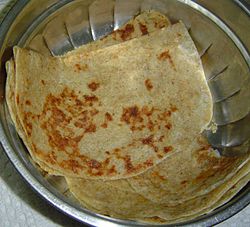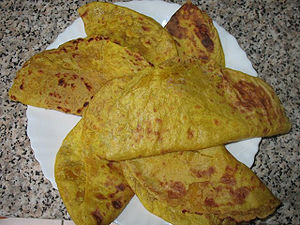- Puran Poli
-
Holige OR Puran Poli 
Holige or Puran PoliOrigin Alternative name(s) Holige, obbattu, poli, puranachi poli, god poli Place of origin India Region or state All of Maharashtra, Gujarat, Goa, Karnataka, parts of north Tamil Nadu Dish details Serving temperature Hot, sometimes room temperature Main ingredient(s) Wheat, sugar, yellow gram Puran Poli (Marathi: पुरणपोळी or पुरणाची पोळी, Konkani: पुरणपोळी or ಉಬ್ಬಟ್ಟಿ, ಹೋಳಿಗೆ, Gujarati: પોળી, Kannada: ಹೋಳಿಗೆ or ಒಬ್ಬಟ್ಟು, Tamil: போளி) is a traditional type of sweet flatbread made in India in the states of Maharashtra, Gujarat, Karnataka, Tamil Nadu and Goa.
Contents
Ingredients
- 300 gm - Channa dal or split yellow gram
- 300 gm - Jaggery or sugar
- 1 tsp - Cardamom powder, nutmeg powder
- 150 gm - Plain flour
- Ghee
- Warm water
Sometimes toor dal is used in Gujarat. In other places, even moong dal is used, even a mix of different lentils is used in some recipes.
Preparation
Maharashtrian Puran Poli
Puran poli is a classical Marathi dish, which is a dessert served during auspicious occasions and during important festivals such as Holi, Padwa in Maharashtra. Although it resembles like a roti, a poli is actually very different. It is made mostly during holi when the bonfire is lit. The stuffing is known as puran and the outer cover is known as poli. The puran is made by boiling chickpea lentils with a pinch of turmeric for color. When the lentils are cooked and soft, the broth is removed and kept aside. Jaggery or gur is added to the chickpeas and cooked till they are soft. Then the stuffing is removed and sieved through a utensil made specifically for puran to achieve a smoother consistency. Saffron, cardamom, and nutmeg is added for additional flavor. The outer cover is made by making a dough by mixing refined flour, milk and ghee. Equal number of balls are made of the dough as well as the stuffing. The puran is stuffed inside the dough and then rolled out flat using a rolling pin. The poli is then coked on a hot griddle and served with ghee and a soup made from the surp.
The stuffing is cooled to room temperature. Meanwhile, the outer dough is prepared. A very soft, rubbery dough is prepared by kneading polished wheat-flour with a little water and a large amount of oil. This is left soaked in oil for a few hours.
Once both stuffing and dough are ready, the puran poli can be rolled out. A plantain leaf is greased thoroughly on one side with oil or ghee; this is essential to turning out a fine poli. On the greased plantain leaf, a handful of the dough is patted by hand into a mid-sized circle. A small amount of stuffing is placed at the center of this dough, which is wrapped around the stuffing to make a ball. This ball is then rolled carefully using a rolling pin into a large, thin circular pancake shape.
Meanwhile, a griddle is heated over a medium flame and greased. The plantain leaf bearing the poli is inverted over the griddle. The Poli tends to adhere to the griddle, since the latter is hot. Using a spatula, the edge of the poli is held down on to the griddle, while the plantain leaf is peeled away by hand. This leaves the poli on the hot griddle, where it is turned over repeatedly, if needed, until both faces of the poli are roasted to a golden burnish and a fragrant aroma is released. The poli is now ready to eat.
Other states
The method of preparation varies from place to place. Sometimes grated coconut is added in Konkan. Coconut palm jaggery may sometimes be used. Similarly a mix or sugar and jaggery both can be used as a sweetening agent. Normally nutmeg is used as a flavoring agent along the coast which is replaced by cardamom or sometimes both elsewhere.
Methods of rolling the stuffed dough may differ too. Normally, it can be rolled using rice flour which makes the rolling very convenient. On the other hand, in some recipes flour is not used at all, oil or ghee is used to roll it into a flatbread instead. The rolled bread can be roasted with our without any ghee or oil, which sometimes is smeared after its completely cooked.
Serving
Pooran Poli is a Maharashtrian dish. The poli is in itself a delicious sweetmeat and is often eaten as such. It may be served with a spoonful of ghee. Poli is often served with milk, which may be sweetened or flavoured with almonds and pistachio. In certain areas, polis a tangy, tamarind-based sauce (similar to the base of pulihora) is served with the poli, to enhance the experience by combining very disparate flavours. In Maharashtra, the tangy sauce is called katachi amti.
In Goan cuisine and the cuisine of the Konkani diaspora in Karnataka and Kerala, punn-poli or Holgi, is generally served with coconut milk flavored with nutmeg and sweetened with jaggery.
In other parts of Karnataka, holige or bele obbattu is served with ghee and hot milk. A variant of the bele obbattu is the crunchy kai obbattu that is prepared with jaggery and coconut. This is usually eaten dry with ghee.
In the Vidarbha region of eastern Maharashtra, the puran polis are soft, since the stuffing is made with jaggery. In western Maharashtra, the powdered white-sugar version is preferred, resulting in a crunchy puran poli.
References
Categories:- Indian breads
- Indian desserts
- Maharashtrian cuisine
- Flatbreads
Wikimedia Foundation. 2010.

